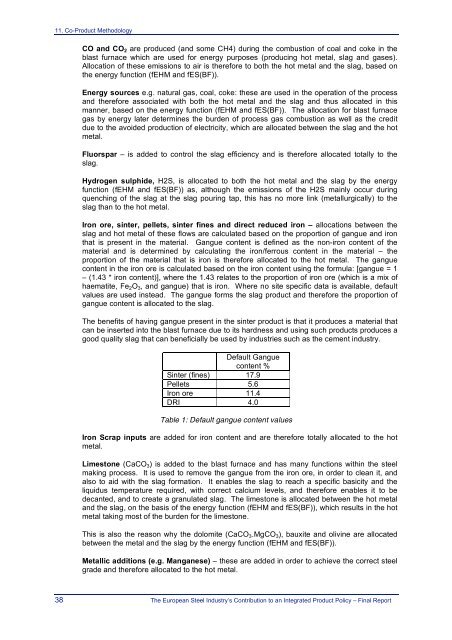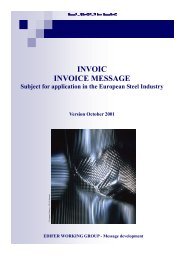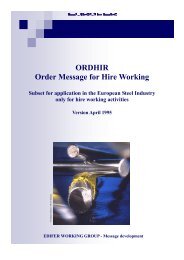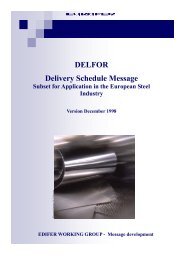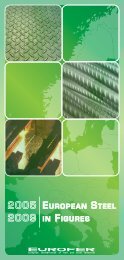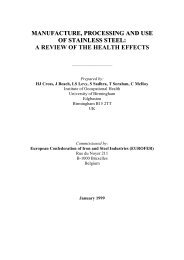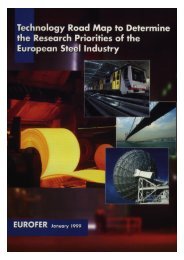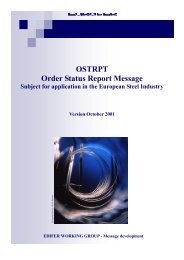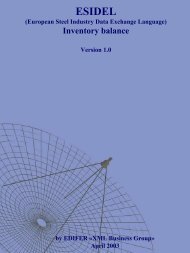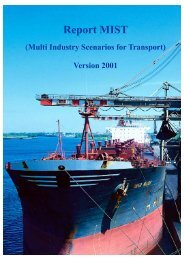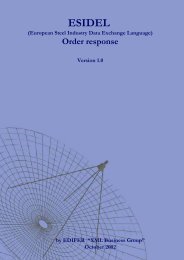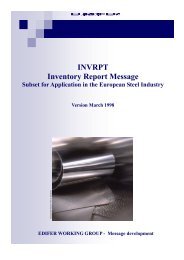pdf - Eurofer
pdf - Eurofer
pdf - Eurofer
Create successful ePaper yourself
Turn your PDF publications into a flip-book with our unique Google optimized e-Paper software.
11. Co-Product Methodology<br />
CO and CO2 are produced (and some CH4) during the combustion of coal and coke in the<br />
blast furnace which are used for energy purposes (producing hot metal, slag and gases).<br />
Allocation of these emissions to air is therefore to both the hot metal and the slag, based on<br />
the energy function (fEHM and fES(BF)).<br />
Energy sources e.g. natural gas, coal, coke: these are used in the operation of the process<br />
and therefore associated with both the hot metal and the slag and thus allocated in this<br />
manner, based on the energy function (fEHM and fES(BF)). The allocation for blast furnace<br />
gas by energy later determines the burden of process gas combustion as well as the credit<br />
due to the avoided production of electricity, which are allocated between the slag and the hot<br />
metal.<br />
Fluorspar – is added to control the slag efficiency and is therefore allocated totally to the<br />
slag.<br />
Hydrogen sulphide, H2S, is allocated to both the hot metal and the slag by the energy<br />
function (fEHM and fES(BF)) as, although the emissions of the H2S mainly occur during<br />
quenching of the slag at the slag pouring tap, this has no more link (metallurgically) to the<br />
slag than to the hot metal.<br />
Iron ore, sinter, pellets, sinter fines and direct reduced iron – allocations between the<br />
slag and hot metal of these flows are calculated based on the proportion of gangue and iron<br />
that is present in the material. Gangue content is defined as the non-iron content of the<br />
material and is determined by calculating the iron/ferrous content in the material – the<br />
proportion of the material that is iron is therefore allocated to the hot metal. The gangue<br />
content in the iron ore is calculated based on the iron content using the formula: [gangue = 1<br />
– (1.43 * iron content)], where the 1.43 relates to the proportion of iron ore (which is a mix of<br />
haematite, Fe2O3, and gangue) that is iron. Where no site specific data is available, default<br />
values are used instead. The gangue forms the slag product and therefore the proportion of<br />
gangue content is allocated to the slag.<br />
The benefits of having gangue present in the sinter product is that it produces a material that<br />
can be inserted into the blast furnace due to its hardness and using such products produces a<br />
good quality slag that can beneficially be used by industries such as the cement industry.<br />
Default Gangue<br />
content %<br />
Sinter (fines) 17.9<br />
Pellets 5.6<br />
Iron ore 11.4<br />
DRI 4.0<br />
Table 1: Default gangue content values<br />
Iron Scrap inputs are added for iron content and are therefore totally allocated to the hot<br />
metal.<br />
Limestone (CaCO3) is added to the blast furnace and has many functions within the steel<br />
making process. It is used to remove the gangue from the iron ore, in order to clean it, and<br />
also to aid with the slag formation. It enables the slag to reach a specific basicity and the<br />
liquidus temperature required, with correct calcium levels, and therefore enables it to be<br />
decanted, and to create a granulated slag. The limestone is allocated between the hot metal<br />
and the slag, on the basis of the energy function (fEHM and fES(BF)), which results in the hot<br />
metal taking most of the burden for the limestone.<br />
This is also the reason why the dolomite (CaCO3.MgCO3), bauxite and olivine are allocated<br />
between the metal and the slag by the energy function (fEHM and fES(BF)).<br />
Metallic additions (e.g. Manganese) – these are added in order to achieve the correct steel<br />
grade and therefore allocated to the hot metal.<br />
38 The European Steel Industry’s Contribution to an Integrated Product Policy – Final Report


